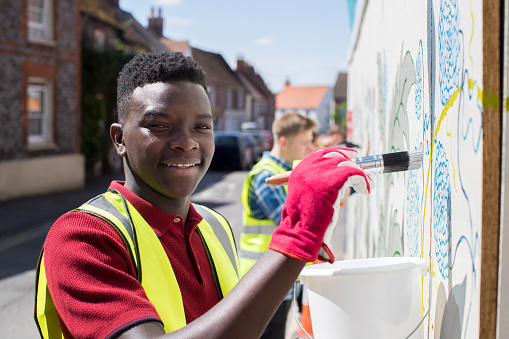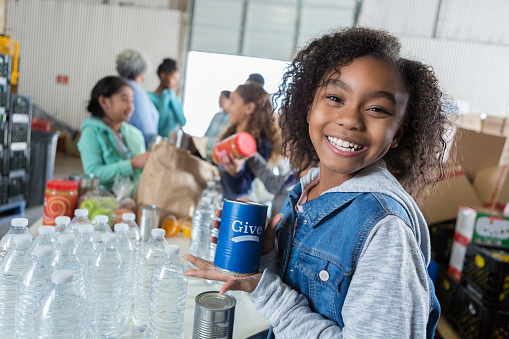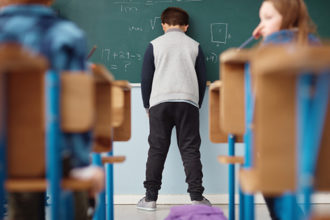We’ve all seen and shared those viral videos—who doesn’t love to see children act in a selfless way? It warms the heart. When children give on a regular basis, it enriches their lives and the lives of the people around them.
As parents, we’re always looking for ways to instill positive values into our children that will help them as they learn and grow. Kids offer so much to the world. Here’s how you can teach the habit of giving in their everyday lives.
Help Others
Giving doesn’t have to be just about money or possessions. It can also be about giving of oneself—and there are plenty of ways children can do that.

For example, kids can help other children with their homework. When I was in middle school, I needed a math tutor. As a result, every Saturday I would go to a local community center to meet my tutor, who was an older child who tutored me for free. It was a great way to make a new friend, too!
Volunteering at a senior center is another great way for a child to give back. Children can help staff with meals and make conversation with the seniors who live at the center. They can also participate in games, exercise and singing activities. Children and teens can gain extra love and encouragement along the way as they learn from the seniors’ stories of their life experiences.

Consider having your children work with you or other adults on fundraisers for charitable organizations. Your child may be passionate about music, the arts, animals or helping other children. Help them find an organization where they can volunteer their time to support an important cause.
Here are a few other ways children can help others:
- Help a neighbor bring in groceries
- Check on elderly neighbors to see how they’re doing
- Mow a neighbor’s lawn
- Help a sibling clean their room
- Bring a neighbor’s trash can back from the curb on trash day
Give Items
We all know children grow up fast, and when they do, they outgrow their clothes. Many times, those clothes go to younger siblings or family members and friends, but there are other options.
Recently, during one of my financial literacy sessions, a young woman shared that as she gets older and outgrows her clothing, she and her Mom wash the clothes, put them in a bag, then go together to donate the clothes to the Salvation Army. Engaging experiences like this have a real impact and offer teachable moments to youth. They also help family members bond in a meaningful way.
Parents often donate clothes and other items to purge clutter or make way for new things, but it is important to include your children in the process and discuss why it’s important to give items away, instead of throwing them away. Kids learn that there is value in items that can be used by others in need. Giving away toys, dishes and other family and household items also offers parents and children a way of giving back that solidifies a value system of giving.
Give Money
Donating money is the most obvious and seemingly easiest way to give. Parents can include their children in the giving that they do regularly.
For example, if a parent gives to their place of worship on a regular basis, they can begin including their children by explaining why they donate and how the money will be used. However, parents can also encourage their children to add their birthday or other gift money to the donation as a valuable, teachable experience.
For many families, giving can also be included with any allowance or earned money your children receive. As they plan to spend their money on food and snacks—and save some in their piggy bank or a savings account—talk to them about the things they care about.
Teach them that part of making money, and money management is giving to help others. To help in the effort, parents can take part of their children’s allowance and give it to a cause and organization they both discuss and decide on. After that, birthday money, holiday money—even money earned on jobs like mowing the grass and babysitting—can be used to help others.
Explain that even though they are young, they can make an impact by giving to students at a school that needs help or donating to a city that is recovering from a natural disaster, or they could contribute to a worthy cause that will directly benefit an issue that is important to them.
If you need an example of the power of giving back to show a child why it is important, visit the Power of Positivity Facebook page. It includes an awesome video from Aug. 30, 2017 that shows a classroom of children sharing some of their food with a fellow classmate who doesn’t have his own lunch. It’s a very heartwarming example of the importance of giving.
These are just a few ways to get children thinking about giving back to others and caring about the world around them. Take time to discuss these and other options, and make it a fun family affair. You may even want to include your children’s friends and other neighborhood or school families. This will help to develop a lifelong tradition of giving to others.
Kolonji Murray is the author of “Bank Magic: Financial Literacy for Young People” and president and founder of tax accounting firm TaxAssurances, LLC. For nearly 20 years he has advised clients as a financial advisor, personal banker, insurance broker and tax accountant.





